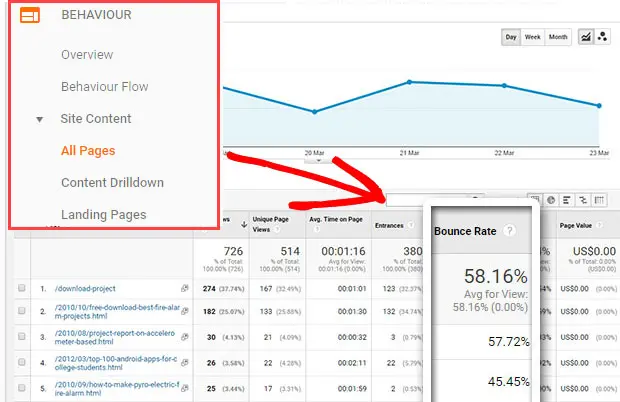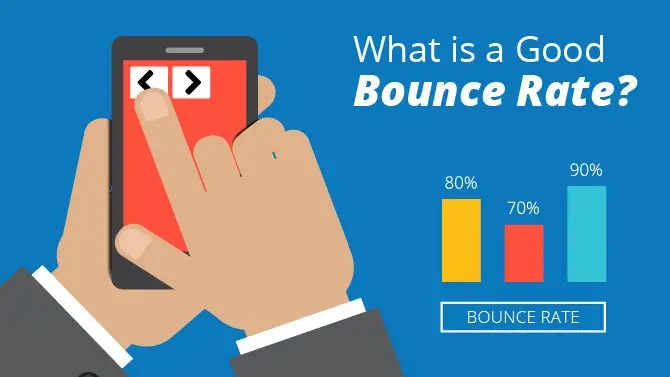Somebody comes to your website and they automatically leave that’s terrible right? That’s something called “Bounce Rate”.
Hello everyone! And today I am going to tell you what bounce rate is and how to deal with it on your website to get more conversions.
So what is Bounce Rate?
Bounce rate is basically the percentage of people that come to a page and then automatically leave and they don’t go to another page on your website.

So we will give you a real world example –
Say somebody Google for something like say SEO reporting maybe search – related reporting they come to our page and then automatically leave that would be considered a bounce and a bounce is not always something that’s a bad thing.
In some cases certain industries and certain websites have a much higher bounce rate then another’s. For example – Say that somebody is doing a search and they land on the site and they find the exact information that they were looking for and then they leave. You actually kind of served the user correctly there and they got what they wanted and they got in and out.
The issue is that the bounce rate can be something that can be an indicator of a poor business model. So when somebody comes in there automatically and leave in many cases they don’t actually complete a transaction they don’t view many Ads that you would like them to view, but they don’t, and also they don’t even leave their email address, i.e. they don’t put in a lead right?
So bounce rate which is very very high and usually the higher the bounce rate the worst it is for the website can be an issue.
So next we are going to talk about a little bit about bounce rate and what you need to know for your site.
So first how do you find your bounce rate?
Well! The best way is to go inside of a tool which is Google Analytics and they are going to tell you about your bounce rate overall for the entire website. They are going to tell you a bounce rate by source and what you need to do for your individual channel. You can check bounce rate by your location or by a device on that it is set either on mobile or you can look at it by landing page.

You can even look at it by some of the traffic to the landing page. So you can slice and dice bounce rate in a whole bunch of different ways and that’s pretty important because bounce rate from a certain area could be much higher than other area.
For example: Maybe you only serve the United States right? Your company serves only United States or UK, the people are coming to your website from all over the world. They come in from India, or they come in from France, in that case those people might come in then automatically bounce once they realize that you don’t serve their region. So bounce rate is all generous and very important to keep in mind that context.
Individual landing pages might have a higher bounce rate than the others. If you have a page that just gives somebody a quick answers. So somebody might come in automatically and leave if you have a page that has in depth information and then offers a guide that might make it easy, so that somebody doesn’t bounce and increases your page rate per visit. So in some cases you will see that a lot of big news sites they do things intentionally to reduce their bounce rate.
And usually when you look at a news site they are looking for things like time on site, they are looking for things like pages per visit and other sections because they are able to serve more Ads and make more money.
So there are few sites in a lot of cases they are serving similar articles, so it might be a widget that comes in or they might have a side bar for their top articles of the day so that you can continue to get more business and they want to keep you on the site as long as possible.
So a little bit text around bounce rate, its generally the best way to figure it out you go inside of Google analytics and you look at few other websites and you try to use your own kind of individual review and ideas on the website. Is this too high? Is it too low and when you look at the metrics based on the individual demographics and the content on the page, does that make sense?
Ok! So what is a good bounce rate?

Say for retail sites: Usually it’s between 20% to 40% for a simple landing page. It’s like a paper click landing page or a service landing page or that just matches to your requirements usually a bounce rate for that is between 70% to 90%
Now for a Portal website: So somebody is coming in and then logging into something like may be AOL and going to their email or they are going to Gmail, so the bounce rate for something like that is usually between 10% to 30%
For self – service and FAQ types of sites the bounce rate is usually also between 10% to 30% and now for a content type of sites the bounce rate is usually between 40% to 60% so if you are doing content marketing 40% to 60% is about right.
For lead – generation sites the mean is about 30% to 50% as far as your bounce rate.
For general reference anything over 80% is really bad, anything between 70% to 80% is ok, anything between 60% to 70% is also okay, higher but ok. Anything in the 50% range is little bit better and getting lower is generally a pretty good scale.
So that’s just a kind of general metrics for you to think about.
Ok! So we talked about the numbers, now let’s talk about what’s actually causes bounce rates?
- Slow load time – If your web page is taking forever to load then people are going to leave. So make sure that your web page has to load fast.

- Inaccurate titles or descriptions – So if somebody does a search for something, they click it and they come in or if they click on an Ad and they come into the landing page, so whatever they came in for doesn’t match the landing page then they are going to bounce, right? So you need to make sure that the customer sees it seamless or whatever cause him to come to your site they see it when they land. It means their expectations.
- If you got a bounce rate lower than 20% there is a real chance to thought about improper analytics setups – That happens a lot. Sometimes there will be like 2 instances attacking code on a page or something through Google tag manager on the main site. In some cases, an improper analytics setup is going to make your bounce rate look really low and you are going to feel really good about yourself, you are so excited that ”Hey! We have the lowest bounce rate!” You are going to tell that to your friends but really they just think your analytics? So make sure you check that.
- Item number 4 that causes a bounce rate to be very high is – Un-mobile friendly site – If your site is not people friendly, people come in, they come in for some search, and if the desktop site is squeezing in their mobile phone, they are going to bounce. So make sure that you take that time that’s important for so many information’s.

- Maybe your page isn’t engaging – Maybe your page doesn’t have
good design; maybe your pageis just not have enough information. Maybe people just get in there and they get underwhelmed, so make sure that you have got a great web experience that’s going to be important for bounce rate.
So how do you improve your bounce rate?
First thing you need to do is to examine the target audience. One of my favorite things is to do an analytics audit. So you go through a clients all the analytics you know, from the location into every single landing page to every single source, maybe the languages that they speak, what cities they are in and based on that you can do a pretty good job of building a persona and or that exact type of person that is coming to your website and then based on that you can detect things like what type of power schemes do they like, what type of images does this person like. You can build a web experience that’s really going to match what the person is looking for. So that’s a really good place to start.Second thing is compiling the lines what I just said. You got to check every single traffic channel. So what I do on a daily basis is I look at is the traffic up this day from the same day last week? And what are the traffic channels that are driving that traffic? What is every single source of traffic coming to your site? And what is the specific landing page? And what is metrics associated with that? What is the bounce rate? So by doing that and going through piece by piece, you really kind of improve that experience and that’s going to help you to fall your bounce rate. So it will reallygoing to help in the conversion and sales right? So I highly recommend you to do that.- Make sure to include relevant links and suggestions as I really like to give lots of content on the internet so you can start with simple maybe depending on the type of page and as you go further you make sure that you are catering to every single thing that the user wants, right?
- There might be facts, keys, figures, Blog posts give them as much as around the topic you can. By doing that you can be sure that you give what the user wants. They are going to click to other parts of the site and explore the website and that’s really going to reduce the bounce rates.
- Have a call to action – Have a couple of clients who have come in recently and they have been working with other companies for a long time and they didn’t even have a call to action that’s about the phone. So don’t be afraid to put a bug if somebody’s on the page they are usually there for a reason so they should be searching for an option, you should give them some options or something to locate and so they come in and click on it and they get some type of conversion or go to another page and that’s going to decrease your bounce rate.
Ok! So bounce rates are really important but you should always be improving it. So that’s it for today! Make sure to leave a comment in the comment section below.
Visit- Best WordPress Hosting

You must log in to post a comment.